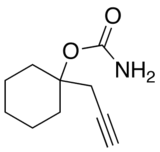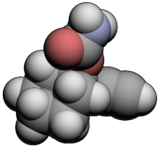Hexapropymate
From Wikipedia, the free encyclopedia
This is an old revision of this page, as edited by CheMoBot (talk | contribs) at 12:59, 26 September 2016 (Updating {{infobox_drug}} (changes to verified and watched fields - updated 'ChEMBL_Ref') per Chem/infobox_drug validation (report errors or bugs)). The present address (URL) is a permanent link to this revision, which may differ significantly from the current revision.
 | |
 | |
| Clinical data | |
|---|---|
| ATC code | |
| Identifiers | |
| |
| CAS Number |
|
| PubChem CID | |
| ChemSpider |
|
| UNII | |
| ChEMBL | |
| CompTox Dashboard (EPA) | |
| ECHA InfoCard | 100.006.018 |
| Chemical and physical data | |
| Formula | C10H15NO2 |
| Molar mass | 181.232 g/mol g·mol−1 |
| 3D model (JSmol) | |
| |
| |
| | |
Hexapropymate is a hypnotic/sedative. It has effects similar to those of barbiturates and was used in the 1970s-1980s in the treatment of insomnia before being replaced with newer drugs with improved safety profiles.[1]
References
- ^ Gustafsson, L. L.; Berg, A.; Magnusson, A.; Malmlund, H. O.; Sandell, B. M.; Stig, R. (1989). "Hexapropymate self-poisoning causes severe and long-lasting clinical symptoms". Medical toxicology and adverse drug experience. 4 (4): 295–301. doi:10.1007/bf03259914. PMID 2770531.
| Alcohols | |
|---|---|
| Barbiturates |
|
| Benzodiazepines |
|
| Carbamates | |
| Flavonoids |
|
| Imidazoles | |
| Kava constituents | |
| Monoureides | |
| Neuroactive steroids |
|
| Nonbenzodiazepines | |
| Phenols | |
| Piperidinediones | |
| Pyrazolopyridines | |
| Quinazolinones | |
| Volatiles/gases |
|
| Others/unsorted |
|
Hidden categories:
- Articles with changed ChemSpider identifier
- Articles with changed EBI identifier
- ECHA InfoCard ID from Wikidata
- Chem-molar-mass both hardcoded and calculated
- Infobox-drug molecular-weight unexpected-character
- Articles with changed InChI identifier
- Chemical pages without DrugBank identifier
- Articles without KEGG source
- Drugs with no legal status
- Drugboxes which contain changes to verified fields
- Drugboxes which contain changes to watched fields
- All stub articles
